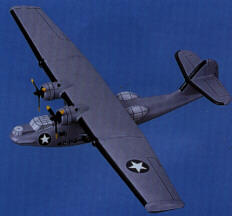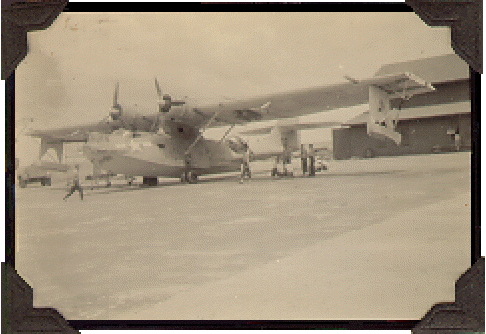|
NAS GROSSE ILE
This is a photo furnish by John K. Evans of his fathers PBY. This is a PBY5 and his unit was VP-91 of Fleet Air Wing #1 Hedron. They were stationed at Pearl Harbor (Hawaii), Fiji Islands, New Britain, Noumea (New Caledonia), Buna-Hollandia-Munda (New Guinea), Espiritu Santo-Halavo Bay (New Hebrides, New Ireland (Solomon Islands) and Stewart Island (New Zealand). His father was an AOM1c (Aviation Ordnanceman 1st. Class Orphy Boyd Evans and was the gunner in the left blister. His father died on veterans day in 1978. We place this photo as memorial to AOM1c Orphy Boyd Evans, his plane and crew. The PBY was one of the slowest combat aircraft in W.W.II. By the beginning of the war the Navy had already ordered the next generation of flying boats. The Catalina would be hard to replace though, with the original boat being modified into many new versions which outsold its newer replacements. By the end of production there had been more Catalinas delivered than any other flying boat or float plane in history. Its range of 3000 miles is impressive and its reliability is unmatched. In W.W.II the Catalina had a distinguished record, used mainly in ASW and escorting convoys. The PBY first flew in 1935 and after flight test, flew 3,443 to set a distance record. In 1940 the PBY-5 variant offering two Pratt & Whitney R-1830-32 Twin Wasp 1,200 H.P. each. Wingspan 104 ft., length 63 ft. 10 in. Armament: 5 machine guns. The parasol wing monoplane known as the "Cat" spotted the German battleship "Bismarck" after the sinking of the British battleship "Hood". Having the ability to fly long hours the aircraft was ideally suited for convoy guarding patrols. Alternatively the "Cat" could carry eight 325 lb. depth charges or two 2,000 lb. bombs under the wings.
Web Master
|


